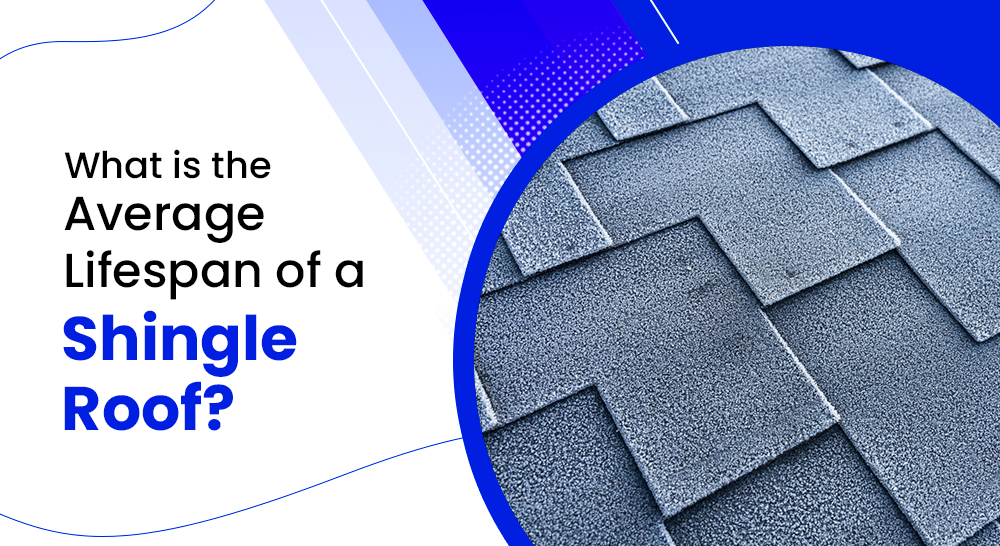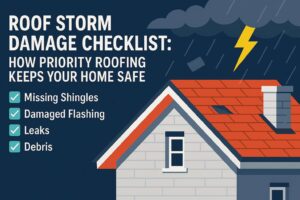Are you curious about the average lifespan of a shingle roof in the U.S.? If you are a homeowner in the U.S., then you must be. How long a shingle will last before needing replacement mainly depends on how the regional climate in the country affects the longevity, whether you are located in the Northeast, Midwest, South, or West.
This blog will cover the national average lifespan of the shingle in the U.S., regional climate impacts, and the top five factors that impact the shingle roof lifespan. Let’s get started on the topic in detail so that you can make informed decisions if you are thinking of roof replacement or a new roof.

What are Asphalt Shingle Roofs?
Asphalt shingles are the most commonly used roofing material in the U.S. Why do you think it is? It is mainly because of its affordability, ease of installation and solid performance across most climates in the U.S., whether it’s heavy winters, storms or the hot and dry climate. Asphalt shingles are typically made from a base mat, which is usually fibreglass coated in asphalt and topped with mineral granules.
You would come across three main types of roof shingles used in residential roofing when you research asphalt shingle roofing as follows:
3-Tab Shingles
It is the most basic type of asphalt shingle roofing, and if you are budget-conscious when it comes to roofing, 3-tab shingles would be the best option for you. In terms of appearance, they appear flat and uniform and create a clean and simple look, and they are lightweight, which makes them easier and faster to install. It is ideal for rental properties, cost-conscious builds, and homes where minimal aesthetic appeal is acceptable.
Architectural Shingles
It is also known as dimensional shingles, the most popular choice of many homeowners in recent times. Architectural shingles feature a multilayer construction, improved wind resistance, a longer lifespan than 3-tab shingles, along with enhanced curb appeal and better warranty coverage. It offers strong performance along with improved thermal resistance and durability against wind uplift.
Luxury Shingles
The best choice for asphalt roofing is luxury shingles, which are more robust and heavier, offering superior protection from the severe weather common in the United States. They are used for high-end homes and are on the pricier side. While Priority Roofing specialises in designer materials such as clay and slate, these luxury asphalt shingles offer a balance of aesthetics and durability.
Average Lifespan of a Shingle Roof
Now that you have read about the three different types of shingle roofs, let’s have a look at the average lifespan of a shingle roof, which is essential for planning maintenance, estimating the need to replace roof shingles, and ensuring long-term protection for your home. Here’s a breakdown for your information.
| Shingle Type | Lifespan (Years) | Estimated Cost (Per Sq Ft) | Best For |
| 3-Tab Shingles | 15 – 20 | $3.00 – $4.50 | Budget-friendly roofs |
| Architectural Shingles | 20 – 30 | $4.00 – $7.50 | Standard residential homes |
| Luxury Shingles | 25 – 40 | $7.00 – $10+ | Premium homes, upscale properties |
Note that your roof’s lifespan can vary significantly based on where you live and how well your roof is maintained.
How U.S. Climate Zones Affect Shingle Roof Lifespan
As mentioned, the U.S. climate zones play a significant role when it comes to their effect on the longevity of shingle roofing, especially in areas such as the Northeast and Midwest, the Southwest and West Coast, the Southeast, and the Central U.S. So, let’s have a discussion about the climate zones of these regions and how it affects the roofing.
1.Northeast & Midwest (Cold and Snowy Winters)
The Northeast and Midwest regions of the U.S., including Grand Rapids, Minneapolis, and St. Louis, experience heavy snowfall and cold winters, which often result in ice dams and freeze-thaw cycles throughout winter and early spring.
Impact on Roofing:
- Freezing and melting of snow due to fluctuating temperatures around the freezing point cause the shingles to shift or crack.
- Leaks and insulation damage can result from ice accumulation along a roof’s edge.
- In addition to snow accumulation, it also results in heat loss and snowmelt.
2.Southwest & West Coast (Hot / Dry Conditions)
The Southwest and West Coast regions of the United States are Albuquerque, Amarillo, Colorado Springs, Denver, and Los Angeles. These regions are known for high levels of solar UV radiation, dry weather, and day-to-night temperature variations. This is especially true for high-altitude cities like Denver and Albuquerque.
Impact on Roofing:
- UV light accelerates the fading, curling, and brittleness of asphalt shingles
- Big temperature differences cause the expansion and contraction of the roofing
- Increased heat stress on materials due to less moisture.
3.Southeast (Humid, Storm-Prone)
Southeast cities in the United States (Jacksonville, Lakeland, Orlando, and Houston) have a hot, humid, and storm-prone climate. Heavy rains, intense sunlight, high winds from storms, and occasional hurricanes are common in the area. Therefore, the likelihood of these challenging environments affecting the roofing is high.
Impact on Roofing:
- Algae, mould and mildew growth negatively impact the roofing system.
- Shingles tend to crack, curl or blister when exposed to UV and heat.
- Water infiltration in the roofing is another problem caused by heavy rainfall.
- High winds from storms or hurricanes can lift or tear off shingles.
- Shingles may get cracked or bruised by hail, which can cause leaks, particularly in Houston.
4.Central U.S. (Hail & Tornado Zone)
The central United States, which includes cities such as Austin, Dallas, Oklahoma City, and Kansas City, is known for being a region prone to tornadoes and hail. The following effects are caused by the extreme weather conditions that put asphalt shingle roofing systems under a lot of stress: frequent hail, tornadoes, strong winds, and sharp temperature swings.
Impact on Roofing:
- Dent, bruises, or crack on asphalt shingles are caused due to hailstorms in the Central U.S.
- High wind events or tornadoes may cause either lifting or tearing off of roofing completely.
- Thermal expansion can cause cracking, warping, or loosening of the materials over time.
- Branches and airborne flying debris can puncture or tear shingles during heavy storms and rain.
Top 5 Factors Impacting Shingle Roof Lifespan
Understanding the top five factors that influence the asphalt shingle roof lifespan of your shingle roof can help you extend its life
- Climate Exposure: Weather conditions of various regions we mentioned in the above section is one of the five influencing factors on the roof lifespan. So, the roofing materials chosen should be region-specific and with a knowledge of local weather patterns.
- Quality of Installation: Installation quality is important because anything like a misaligned shingle or poor nailing can cause your roofing to leak or blow off. So, you should approach a certified and experienced roofer like Priority Roofing to ensure that your roof is performing as intended.
- Material Quality: It is, of course, an impacting factor on the shingle roof lifespan. An investment in high-quality roofing material would be beneficial in reducing both repair costs and the cost of replacing roof shingles.
- Insulation & Ventilation: Proper insulation and ventilation are essential to ensure adequate airflow and control temperature and moisture levels. If it fails to do so, the chances of shingles degrading increase.
- Roof Maintenance Frequency: A well-maintained roof can help you identify minor issues, allowing you to address them promptly before they escalate. Conduct regular inspections, remove debris, and address any other matters noted to prolong your investment’s lifespan and potentially exceed its expected lifespan by several years.
You now have a better understanding of how long shingle roofing lasts, and you know that its lifespan depends on various factors, including climate, installation quality, ventilation, and regular maintenance. Each region presents its own set of challenges, from hailstorms in Oklahoma to the humidity of Florida and heatwaves in Texas. You can considerably prolong the life of your roof by being aware of these factors and taking preventative action.
Wherever you are in the U.S., we can help you get your roofing or maintenance done, protecting your home and your wallet. Why wait? Book a free inspection today!


